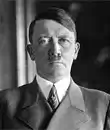
Day-by-Day Timeline of Events
Monday, April 16th, 1945
The Soviet Army begins its Berlin campaign with spectacular display of artillery, exploding targets throughout Berlin and its surrounding areas. The bombardment signals the beginning of the offensive to take the German capital.
Monday, April 20th, 1945

Tuesday, April 21st, 1945
General Zhukov and his 1st Belorussian army break into the Berlin suburbs.
Wednesday, April 22nd, 1945
Soviet leader Stalin sends his final assault orders to generals Zhukov and Koniev.
Thursday, April 23rd, 1945
The Berlin suburbs gradually fall under Soviet control as fighting rages on everywhere.
Friday, April 24th, 1945
German General Wenck of the 12th Army launches a futile counter-offensive against the Soviet onslaught.
Friday, April 24th, 1945
The British Royal Air Force slow down the 12th Army offensive through intense bombing.
Saturday, April 25th, 1945
The 1st Belorussian Front meets up with the 1st Ukranian Front, formally encircling Berlin.
Saturday, April 25th, 1945
All access points west of the German capital are cutt off by Soviet forces.
Saturday, April 25th, 1945
Over 2 million Berlin civilians hunker down for the violent fighting ahead.
Saturday, April 25th, 1945
Some 30,000 German soldiers ready themselves for the bloody business of the day.
Saturday, April 25th, 1945
Elements of the 5th Guards Army reach the Elbe River at Torgau and celebrate with the arriving US 1st Army.
Monday, April 27th, 1945
German soldiers set up defensive areas across a small 10 mile long front for their ultimate "last stand".
Monday, April 30th, 1945

Monday, April 30th, 1945
The bodies of Adolph Hitler and Eva Braun are taken to the Chancellery Gardens and incinerated under previous orders from Hitler, this to avoid capture and ultimate humiliation at the hands of the progressing Soviet Army.
Tuesday, May 1st, 1945
Soviet artillery opens up once again, this time in a massive barrage against the Chancellery and surrounding areas.
Tuesday, May 1st, 1945
German propaganda minister Joseph Goebbels murders his wife and six children before taking his own life.
Tuesday, May 1st, 1945
German Generaloberst Hans Krebs approaches Chuikov with the formal German surrender.
Tuesday, May 1st, 1945
Berlin formally and unconditionally surrenders to the Soviet legions and Western Allies. General Jodl signs for the defeated Germans and Generals Bedell Smith and Suslaparov for the Allies.
Wednesday, May 2nd, 1945
The Fall of Berlin is complete - Soviet forces occupy all major sections of the German capital.